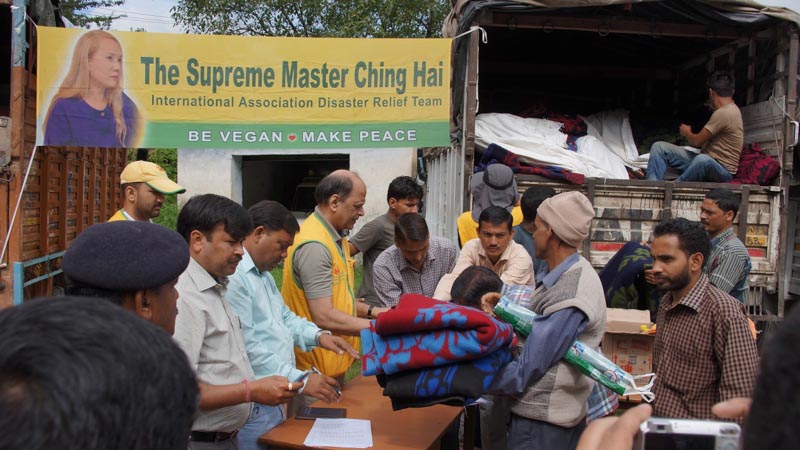By Formosa Relief Team (Originally in Chinese)
Days of heavy rains in mid-June of 2013, estimated as the heaviest in the area in 88 years, caused severe flooding and mudslides in Uttarakhand, India. As a result, more than 5,700 people lost their lives and 70,000 were affected, most of whom were in Uttarakhand for an annual pilgrimage. After learning the tragic news, Supreme Master Ching Hai immediately provided a US$50,000 fund and sent a relief team to the disaster area.
After our departure from Taipei, Formosa, our relief team arrived in New Delhi, India on June 26. The next day, we went to Dehradun, the capital city of Uttarakhand, and visited the Jainism religious group to find out the needs of the disaster-affected people. We then decided to go to the areas that needed help the most and where few others were planning to go. In the evening, we purchased relief items for the 7,393 affected households, including 1,000 blankets and 1,000 bottles of soy milk, as well as 10 kilograms of flour, one kilogram of sugar, one kilogram of beans and one kilogram of cooking oil for each household.
On June 28, we traveled in the Himalaya Mountains for one day before arriving in Rudraprayag. Because it was difficult to travel on the mountain road, the relief items did not arrive until a few days later. From June 30 to July 4, we went to the village of Agastyamuni, a few other nearby small villages, and Ukhimath, which were severely hard hit by the disaster, to provide relief items. We also distributed relief items to small villages we passed by. The local officials in Ukhimath assisted us in our relief activity.
We visited a local chief in the mountainous area in Rudraprayag. The chief told us that when the flood came, he was praying in a temple. Within a split second, he held on to a stone cow statue in the front gate of the temple and kept holding on for an hour as the floodwaters rushed by. That’s how he survived. As the stone cow is a symbol of God Shiva, he believes that it was the Lord Shiva who saved him. During the next few days, in spite of the hot weather, the chief was very dedicated in gathering the village heads and helping us distribute the supplies to those in need.
On July 5, we traveled to one of the worst affected areas, Kedarnath, which is comprised of many small villages. Because the road was blocked, we had to walk on a mountain path for several kilometers. After crossing the river, we entered the mountain areas in a vehicle sent by the local government. Thanks to the shops and truck drivers in Rishikesh, a city near Dehradun, more relief supplies that we purchased and arranged for there earlier arrived. Some roads in the mountain areas in Kedarnath were not accessible by car. We were able to distribute 1,250 packages of relief items and 450 blankets.
Over the next two days on the way back to Rudraprayag and Rishikesh we provided relief items to disaster victims and disadvantaged people in the villages. We gave the remaining 325 packages to local religious groups who would help distribute them to those in need.
Expenditures by Supreme Master Ching Hai and Her International Association
for Flood and Mudslide Relief Work in India
| Description | Amount (INR) | Receipt |
|---|---|---|
| Food (oil, beans, sugar, flour and soy milk) | 2,752,164 | A, C |
| 1,000 blankets | 225,000 | B |
| Total | INR 2,977,164 (US$50,036) |
During the relief operation, the team members paid US$17,747 for their own transportation, food and accommodations.
 The Supreme Master Ching Hai
The Supreme Master Ching Hai
